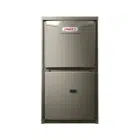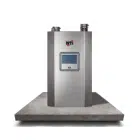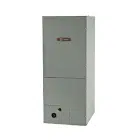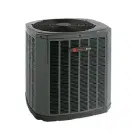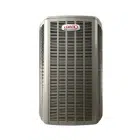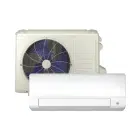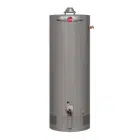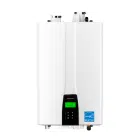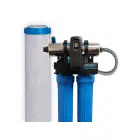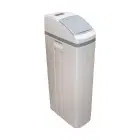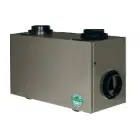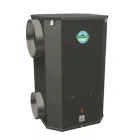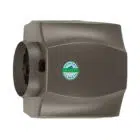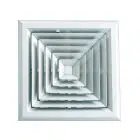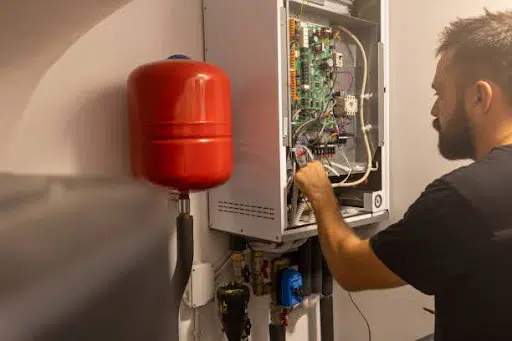
Table of Contents
A furnace pressure switch might seem like a minor part, but when it fails, it can cause the whole heating system to shut down, leaving you in the cold. Knowing what this switch does, why it fails, and how to troubleshoot it is essential for keeping your home warm and safe, especially in a Canadian winter.
The furnace pressure switch’s main job is to confirm that harmful exhaust gases from your furnace’s combustion are vented outside. When functioning correctly, the switch senses airflow from the inducer motor. But if there’s no airflow, the switch prevents the furnace from running, stopping dangerous gases from building up in your home. So, what happens when a pressure switch fails? Let’s explore the causes, signs, and steps to fix it.
Causes of Furnace Pressure Switch Failure
There are several reasons a furnace pressure switch might stop working, often due to airflow or component wear. Here’s what to look for:
Blocked or Restricted Vents
Furnace vents located outside are exposed to the elements, which can cause clogs—leaves, snow, or even birds’ nests can block airflow. When these are blocked, the pressure switch senses the obstruction and shuts down the furnace.
Damaged Diaphragm
Inside the switch, a diaphragm detects air pressure changes, but over time it can develop small rips or holes. This may lead to improper pressure readings, causing the furnace pressure switch to signal a shutdown unnecessarily or, worse, not activate when needed.
Electrical Issues
Loose wires, poor connections, or low voltage can all impact pressure switches. As furnaces rely on specific electric signals, any interference with these signals can make the furnace pressure switch malfunction.
Failing Inducer Motor
The inducer motor creates the airflow that the pressure switch monitors. If the motor is worn or blocked by dust, airflow weakens, and the switch may interpret this as a blockage. Regular inducer motor cleaning can help avoid this issue.
Negative Air Pressure in the Home
In tightly sealed homes or ones with powerful exhaust fans, negative air pressure can interfere with proper furnace operation. This “back-drafting” effect pulls gases back into the furnace, causing the pressure switch to activate repeatedly.
Water in the Pressure Switch Hose
Small amounts of condensation or moisture in the hose can interfere with airflow, triggering the furnace pressure switch to shut down. Even a small blockage from water or dust can cause the switch to misread airflow.
Wear from Age and Use
Furnace pressure switches last around 10-15 years with regular furnace maintenance. Over time, components simply wear out, and the switch becomes less reliable, especially if the furnace hasn’t been serviced regularly.
Detecting a Faulty Furnace Pressure Switch
Knowing the signs of a bad pressure switch can help you pinpoint the issue faster. Here’s what to look for:
- Furnace Won’t Start or Repeatedly Cycles
If your furnace tries to start but fails or cycles on and off without fully igniting, the pressure switch might be sending mixed signals to the control board. - Error Codes on the Furnace
Many modern furnaces display blinking error codes. If a code corresponds to furnace pressure switch issues (usually listed in the manual), it’s time to investigate. - Thermostat or Control Board Messages
Some furnaces display error messages on the thermostat or control board when a pressure switch issue is detected. - Unexplained Cold Spots
If certain areas aren’t warming up, the furnace may be intermittently shutting off because of a malfunctioning pressure switch. - Unusual Noises
Faint clicking or flapping sounds from the furnace often indicate diaphragm issues within the pressure switch. This noise could mean that dust or damage is affecting switch operation. - Lukewarm Air from Vents
If the air coming from your vents is lukewarm rather than hot, it might mean back-drafting, where exhaust gases are being pulled back into the furnace. This could cause the pressure switch to keep activating as it tries to prevent further issues.
Higher Utility Bills
If the pressure switch is causing inefficiencies, it may result in higher heating bills as the furnace struggles to maintain warmth.
Steps to Troubleshoot and Fix a Faulty Pressure Switch
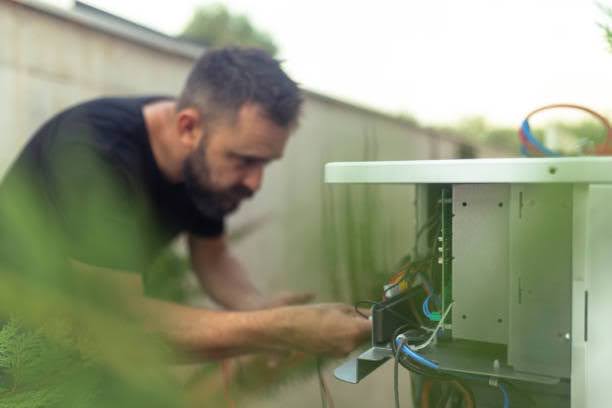
If your furnace pressure switch seems to be acting up, you can try some troubleshooting before calling a professional. Always turn off the power to the furnace first for safety.
- Clear Exterior Vents
Go outside and check that nothing is blocking the furnace’s intake and exhaust vents. Remove any debris, snow, or obstructions that could prevent airflow, as these are common culprits. - Inspect the Pressure Switch Hose
Carefully detach the hose leading to the pressure switch and check for clogs, cracks, or moisture buildup. Shake out any water or debris, and replace the hose if damaged. - Test the Switch with a Multimeter
If you’re comfortable with electrical tools, you can test the pressure switch with a multimeter. Set it to the continuity setting, touch the probes to the switch terminals, and look for a reading of zero. Anything else means it’s likely time to replace the switch. - Clean the Inducer Motor
Dust buildup on the inducer motor can weaken airflow, impacting pressure switches. Carefully clean the motor’s exterior, but avoid disturbing any electrical connections. If the motor is struggling, it may need professional servicing. - Check for Negative Air Pressure
Negative air pressure can interfere with furnace operation. Briefly cracking a window can help, or consult an HVAC professional about adding a fresh air intake to balance the air pressure. - Check the Diaphragm for Wear
Inspect the pressure switch’s diaphragm for wear. If it looks damaged, the pressure switch may not be able to read air pressure properly, and replacing the switch is recommended. - Consult Error Codes
Refer to your furnace manual to interpret error codes on the control panel, which can help you identify if a pressure switch failure or blockage is the issue.
After these steps, restore power and try starting the furnace again. If it doesn’t ignite or if issues persist, a professional technician should be consulted.
When to Call an HVAC Technician
Sometimes a faulty pressure switch isn’t something you can fix on your own, and that’s when it’s best to bring in an HVAC technician. If your furnace still isn’t running after trying the basic troubleshooting steps, or if you’re unsure about any part of the process, a pro can diagnose and resolve the issue without risking further damage to the furnace.
Technicians have specialized equipment to test for issues like negative air pressure or electrical malfunctions that aren’t always visible to the untrained eye. They can also confirm whether the pressure switch itself is the problem or if something else, like a worn inducer motor, is causing the failure. For furnaces over ten years old, they might recommend a complete switch replacement, especially if this isn’t the first time the pressure switch has acted up.
Preventing Future Pressure Switch Failures
Preventative furnace maintenance is essential for keeping your furnace pressure switch working properly. Regularly inspect the furnace’s exterior vents for buildup, clearing away snow, leaves, or other debris that could block airflow.
Annual inspections by a certified technician are also highly recommended. These inspections typically include cleaning the inducer motor, checking the pressure switch hose, and making sure electrical connections are secure. Consistent maintenance ensures that furnace pressure switches and other parts operate efficiently.
For homes with tight sealing, introducing ventilation to prevent negative air pressure can also help. This can be as simple as cracking a window or adding a fresh air intake system that balances indoor air pressure with the outside environment.
Conclusion
A furnace pressure switch is small but essential for your heating system’s safety and function. When it fails, it can lead to significant interruptions or safety issues. Knowing the causes, signs, and troubleshooting steps for pressure switch failure can help you address issues quickly. Regular maintenance and a few preventative measures will keep your furnace working efficiently, helping you avoid unexpected downtime and keep your home warm all winter long.
For expert service and advice, reach out to our HVAC Service Solutions team in Canada. We’re here to ensure your furnace operates safely and efficiently, keeping you comfortable in the harshest winter conditions.
Frequent Asked Questions
What is a furnace pressure switch, and why is it important?
A furnace pressure switch is a safety component that monitors airflow in your furnace to ensure exhaust gases are vented outside the home. It works alongside the inducer motor, which creates negative air pressure to push exhaust out. The pressure switch detects this airflow, signaling the furnace to continue running if everything is operating correctly. If the airflow is disrupted—due to vent blockage, motor issues, or pressure imbalances—the pressure switch shuts down the furnace to prevent dangerous gases like carbon monoxide from accumulating indoors. This function makes it a critical safety feature, particularly in gas furnaces.
What are common symptoms of a faulty furnace pressure switch?
Symptoms of a failing pressure switch include the furnace failing to start, cycling on and off, or producing lukewarm air. Some furnaces display blinking error codes related to pressure switch malfunctions, which can help with diagnosis. You may also hear clicking noises, as the switch tries to open or close but fails. Additionally, you might experience cold spots in the home, indicating that the furnace isn’t running as it should. If utility bills increase unexpectedly, it can also signal an efficiency problem tied to pressure switch issues.
How does a blocked vent affect the furnace pressure switch?
Blocked vents can prevent proper airflow through the furnace system, which the pressure switch detects as a safety concern. This blockage might be caused by debris, snow buildup, or even nests if vents are exposed to the elements. When the switch senses that gases can’t escape, it shuts down the furnace to avoid back-drafting, where exhaust gases are drawn back into the home. Regular vent checks and cleaning can help prevent this problem, especially after severe weather.
What can cause water to collect in the pressure switch hose?
Condensation buildup or leaking from other furnace components can lead to water accumulating in the pressure switch hose, causing the switch to misread pressure. This is a common issue in high-efficiency furnaces that create moisture as part of their heating process. A small amount of water can block airflow, leading the pressure switch to interpret it as a malfunction. To address this, the hose should be inspected and, if necessary, cleared or replaced to restore proper function.
Can I bypass the pressure switch to get the furnace running temporarily?
While it’s technically possible to bypass a furnace pressure switch, doing so is dangerous and not recommended. The pressure switch is a safety feature designed to prevent carbon monoxide and other harmful gases from building up inside your home. Bypassing it could put your household at risk of toxic gas exposure. Instead, try basic troubleshooting like clearing vents or checking the hose, and call a professional if the furnace doesn’t work properly after that.
How can I troubleshoot a furnace pressure switch on my own?
Basic troubleshooting steps include inspecting the exterior vents for blockages, checking the pressure switch hose for cracks, moisture, or clogs, and listening for clicking noises indicating the switch is struggling. If you’re comfortable with electrical tools, a multimeter can check switch continuity. Also, look at your furnace’s control panel or thermostat for error codes. Always turn off power to the furnace before performing any checks, and if the issue persists, calling a professional HVAC technician is recommended.
What are the main causes of furnace pressure switch failure?
Common causes include blocked vents, damaged diaphragms, and electrical issues such as loose wires or voltage problems. A failing inducer motor can also weaken airflow, causing the pressure switch to interpret it as a blockage. In homes with high-powered exhaust fans or sealed rooms, negative air pressure can cause back-drafting, which disrupts the switch’s operation. Over time, regular wear and tear or moisture buildup in the hose can also cause the pressure switch to malfunction.
How does negative air pressure in the home impact furnace performance?
Negative air pressure occurs when the pressure inside the home is lower than outside, often due to powerful exhaust fans or tightly sealed spaces. This imbalance can cause back-drafting, where exhaust gases get pulled back into the furnace instead of being vented outside. When this happens, the pressure switch detects inadequate airflow and shuts down the furnace to prevent safety hazards. Cracking a window temporarily or installing a fresh air intake can balance air pressure and resolve the issue.
How often should a furnace pressure switch be replaced?
A furnace pressure switch typically lasts 10-15 years, though this depends on the furnace’s use and maintenance level. Regular maintenance—such as clearing vents, checking the hose, and ensuring inducer motor functionality—can help extend its life. If a pressure switch fails frequently or if the furnace is over a decade old, it might be more cost-effective to replace the switch during a routine service check.
What steps can I take to prevent furnace pressure switch failure?
Preventative maintenance is key. Regularly inspect the furnace’s exterior vents for debris and clear any buildup. An annual HVAC service check by a licensed technician is highly recommended, as they can inspect, clean, and test the inducer motor, pressure switch hose, and electrical connections. For homes with high airtightness, adding a fresh air intake or balancing indoor pressure can also help prevent negative air pressure issues. These proactive measures can extend the life of your furnace and keep it running efficiently.
Share

